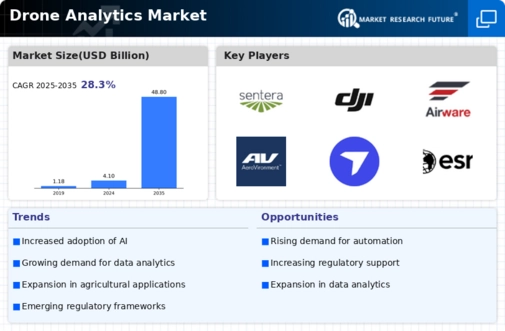Market Growth Projections
The Global Drone Analytics Industry is poised for substantial growth, with projections indicating a market value of 4.1 USD Billion in 2024 and an anticipated increase to 48.8 USD Billion by 2035. This growth trajectory reflects a compound annual growth rate of 25.24% from 2025 to 2035, underscoring the increasing adoption of drone technology across various sectors. As industries recognize the value of drone analytics in enhancing operational efficiency and decision-making, the market is likely to witness significant investments and innovations in the coming years.
Rising Demand for Data-Driven Insights
The Global Drone Analytics Industry experiences a surge in demand for data-driven insights across various sectors. Industries such as agriculture, construction, and logistics increasingly rely on drone technology to gather and analyze data for improved decision-making. For instance, precision agriculture utilizes drones to monitor crop health, leading to enhanced yields and resource optimization. This trend is expected to contribute to the market's growth, with projections indicating a market value of 4.1 USD Billion in 2024, escalating to 48.8 USD Billion by 2035, reflecting a robust CAGR of 25.24% from 2025 to 2035.
Expanding Applications in Various Industries
The expanding applications of drone analytics across diverse industries serve as a crucial driver for the Global Drone Analytics Industry. Sectors such as energy, mining, and insurance are increasingly adopting drone technology for tasks like site inspections, risk assessments, and asset management. For example, energy companies utilize drones to inspect power lines and wind turbines, reducing operational costs and enhancing safety. This diversification of applications not only broadens the market's reach but also stimulates innovation, thereby contributing to the anticipated growth trajectory.
Government Initiatives and Regulatory Support
Government initiatives and regulatory support significantly influence the Global Drone Analytics Industry. Various countries are implementing policies that promote the use of drones for commercial purposes, thereby fostering innovation and investment. For instance, regulatory frameworks that facilitate drone operations in urban areas encourage businesses to adopt drone analytics for logistics and delivery services. This supportive environment is likely to propel market growth, as evidenced by the increasing number of approved drone operations and pilot programs across different regions.
Integration of Drone Analytics in Smart Cities
The integration of drone analytics into smart city initiatives represents a transformative driver for the Global Drone Analytics Industry. As urban areas evolve, the need for efficient monitoring and management of resources becomes paramount. Drones equipped with analytics capabilities can assist in traffic management, infrastructure monitoring, and environmental assessments. This integration not only enhances urban planning but also contributes to sustainability efforts. The growing focus on smart city development is expected to create new opportunities for drone analytics, further propelling market growth.
Technological Advancements in Drone Capabilities
Technological advancements play a pivotal role in the expansion of the Global Drone Analytics Industry. Innovations in artificial intelligence, machine learning, and sensor technology enhance the capabilities of drones, enabling them to perform complex analytics tasks. For example, drones equipped with high-resolution cameras and LiDAR sensors can create detailed 3D maps for urban planning and infrastructure development. These advancements not only improve data accuracy but also broaden the application scope of drones, thereby attracting investments and driving market growth.



 Source Secondary Research, Primary Research, Market Research Future Database and Analyst Review
Source Secondary Research, Primary Research, Market Research Future Database and Analyst Review














